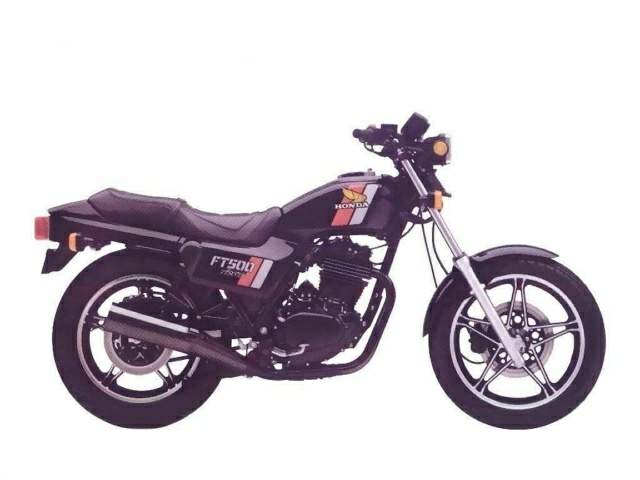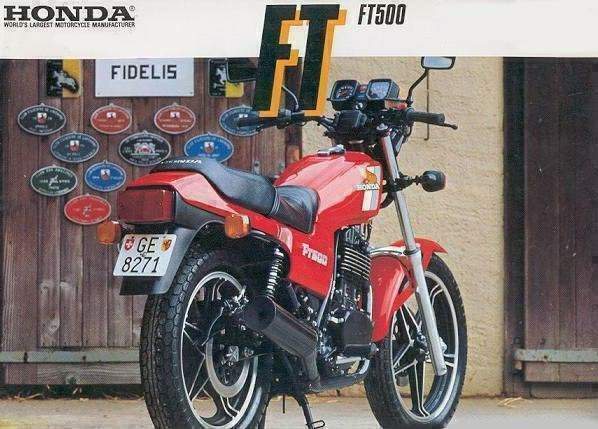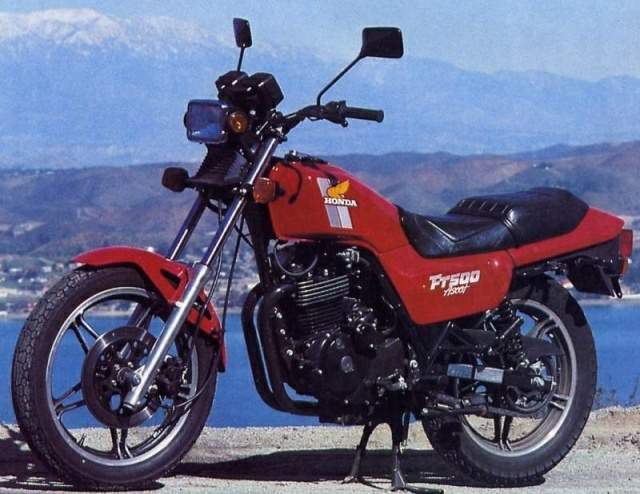what oil to use in honda ft500 ascot
Honda FT 500 Ascot

| Make Model | Honda FT 500 Ascot |
| Twelvemonth | 1982 - 83 |
| Engine | Four stroke, single cylinder, SOHC, 4 valve per cylinder. |
| Capacity | 497 cc / thirty.. cu-in |
| Bore x Stroke | 89 x 80 mm |
| Cooling Organisation | Air cooled |
| Compression Ratio | 8.half dozen:1 |
| Induction | 35mm Keihin |
| Ignition | Bombardment powered inductive |
| Starting | Electric |
| Max Ability | 34 hp / 24.8 kW @ 6200 rpm |
| Max Torque | forty Nm / 29.5 ft-lb @ 5000 rpm |
| Transmission | five Southpeed |
| Final Bulldoze | Chain |
| Front Suspension | 37mm Air assisted forks |
| Forepart Wheel Travel | 152 mm / 5.nine in |
| Rear Interruption | Dual gas shocks, spring preload adjustable |
| Rear Wheel Travel | 84 mm / three.3 in |
| Front end Brakes | Single 296mm disc 1 piston caliper |
| Rear Brakes | Unmarried 276mm disc 1 piston caliper |
| Front Tyre | 3.50-19 |
| Rear Tyre | 4.25-xviii |
| Wet Weight | 175 kg / 385.8 lbs |
| Fuel Chapters | thirteen Litres / 3.iv The states gal |
| Consumption Average | 47.9 mpg |
| Standing � Mile | 15.0 sec / 81.5 mph |
| Top Speed | 93 mph |
The Honda FT500 is a single cylinder, 497cc motorbike produced by Honda during the early 1980s.
Honda FT500 Ascot. FT stands for Apartment Track. Imported from Japan as a 1982 and 1983 model. Did not sell well in the United states of america. Originally at dealerships for $2,195, by 1984 the left-over models were a steal at $1,295. About 32-equus caballus power and 50 miles per gallon fabricated the FT500 a very practical motorbike.
Common Fault.
The FT500C as sold in the UK was electric outset but. The lack of a kick-start caused problems when the rear support bearing of the starter pinion wore out (due to a poorly designed oil feed). Regular replacement of this white-metallic sleeve bearing is vital and should be considered at every major service interval.
Car Modification.
A common engine modification for Datsun Enthusiasts was an FT500C piston upgrade in the ever-popular L28 Inline-six engine, found in a number of 70's Datsuns. Datsun enthusiasts would overbore their engines by 3mm to accommodate the 89-90mm FT500C piston.

Review
QUIRKINESS IS Hard TO DEFINE. LITERALLY, It Ways PECUliar or idiosyncratic. If you're highly individualistic, you probably think of quirky in a positive way�unique. If you're part of the mainstream, you sense another connotation�it just means weird.
In either case, you probably subordinate unusual design or styling to function. At least, we believe that'due south the fashion it should be, and we have reason to suspect the bulk of motorcyclists share that opinion. Basis for our viewpoint is that Yamaha has retreated from the 500cc single-cylinder roadster market place; Yamaha's i-of-a-kind (during the years it was produced) SR500 was indeed quirky, but it didn't exactly take the motorcycling world by tempest.
Why? Mainly because it was at a functional disadvantage compared with its lightweight-class and price-level rivals, the 400-450cc twins. Specifically, information technology vibrated more the counterbalanced twins, and it lacked electrical starting.
Yous can talk all day long about the desirability of unique motorcycles and near your being one of those enthusiasts devoted to mechanical simplicity; if the unique and mechanically uncomplicated motorcar that yous're obliged to buy is a sub-par performer or lacks any significant assiduities, it'south a fair bet that you'll maintain your affection from a altitude.

Honda has filled the void Yamaha created�and is likely to pull in some of the enthusiasts who were attracted to the SR as a concept but disillusioned by the reality of the production. Honda has introduced the Ascot, a 500cc single-cylinder roadster that uses the basic XR/XL powerplant developed for the 79 model year. This engine has up-to-date technological features, including a four-valve head and engine counterbalancers. More of import, Honda fitted the street-going FT with electric starting and did abroad with the kick-offset lever birthday. By taking this logical step, Honda has produced a cycle which will appeal to "purists" for its straightforward design, and compete with other 400-500cc bikes in several categories of function.
There are in fact and theory several good reasons for producing a unmarried-reasons which take nothing to do with style and everything to do with performance and practicality. As a rule of pollex, it'south possible to make a single lighter than a twin; in fact, Honda has given validity to the rule the FT at 378 pounds weighs somewhat less than the 400-450cc twins, which weigh anywhere from 390 to 410 pounds, and significantly less than the occasional 500cc twin on the market; the Honda CX, for instance, weighs 486 pounds, and the Yamaha Vision weighs 468. Singles are also mostly narrower than twins, which allows the manufacturer to pro duce a bike with more basis clearanj In terms of maintenance, a single has fewer carb and four fewer valves (giveTi the aforementioned four-valve cylinder caput design) to adapt.
Those purists who insist that big singles ought to be classic works of simplicity should not be disappointed past the addition of electrical starting. Gone is the kicking starter's idler gears, pinion, ratchet machinery and springs, shaft and kick lever. In this respect the FT has been mechanically and functionally simplified. In whatsoever case, if you've always stalled a loftier-pinch unmarried at mid-intersection during rush hour, yous'll appreciate the lack of fourth dimension-consuming starting drills and the presence of push-push button starting.
Simplicity advocates should also appreciate the efficiency of design of Honda's counterbalancing system. Naturally, information technology requires extra parts and slightly more weight, but Honda'southward designers have kept both to a minimum. The forward balancer rides on its own shaft. The 2d, rearward balancer rides on the existing transmission mainshaft�a feature Honda has patented. In all, the balancing organization consists of the frontwards shaft and balancer, the rearward weight, the concatenation connecting the two balancers, and a few bearings. That'due south as simple a arrangement as whatever manufactory has yet designed for a large unmarried car.
I await at the instrumentation reinforces the belief that this motorbike is at the short end of the mechanical-complexity spectrum. Absent are superfluous�for the sporting purist�information centers; you'll find no fuel approximate, voltmeter, gear position indicator, stand-down indicator, or liquid-crystal monitoring panel with flashing graphic displays.
Instead, you'll detect only pertinent data required for riding: manifestly readable gauges and indicator lights, a nuance-mounted choke lever and easy-working controls and switches.
The 498cc engine resembles Honda's Twoscore and XR powerplants in overall appearance; however, information technology has significant differences. Premier among these, of course, is electrical starting. The primary gears remain identical to the XR/XL's cogs; the second through 5th manual gears take been strengthened. The clutch uses the aforementioned number of plates, but the friction-plate thickness has been increased by 0.4mm to 1,6mm. This year all three of Honda'southward one-half-liter singles feature a cocky-adjusting cam-chain tensioner which requires no routine maintenance.
The FT as well employs engine cases distinct from the XR/Forty's. The main crank-example has a bolt-on sump with a cap covering the oil filter element; oil capacity is increased to 2.4 Litres, a bump of 0.4 liter. Merely the correct-side engine cover is an XR/XL casting; the all-new left-side cases adjust the electric starter.
The starter motor, located behind the cylinder, drives through six reduction gears, for an overall reduction ratio of 29.7:1. A ring gear surrounding the crankshaft-mounted alternator rotor is engaged past a sliding pinion which has a one-style" clutch. This clutch freewheels when the engine outspeeds the pinion, thus disengaging the reduction gears and starter motor and preventing the starter from over-revving.
The Honda uses an unusual start-gear actuating arrangement. During starting, a solenoid, which acts through a locking cam, positively holds the pinion gear and its ane-manner clutch engaged. The solenoid remains energized�and the pinion engaged�as long as the starter button is depressed. Without this feature, the pinion gear would be tricked into disengaging every time the piston gained speed after the compression stroke, even if the engine didn't start.
After cold starting the FT, you tin can immediately ride it away smoothly with only minor choking. The FT pulls from idle, and has a singled-out ability surge above 3000 rpm.
Fifty-fifty though the FT has a good strong accuse in the mid-range, information technology's no Super-bike, as its quarter-mile times betoken. The FT'south height ability is actually shy of the typical 400cc twin; the slowest 400 nosotros tested in our January econo-twin shootout, the Kawasaki KZ440 LTD, beats the FT in the quarter by a one-half-sec-
Single-cylinder engines by nature are very narrow, which allowed Honda to endow the FT with exceptional cornering clearance.
ond and over eight miles per hour.
Compared with its nearly obvious rival, the Yamaha SR500G, the FT is down by 0.20 2d and three.23 mph. The reason for the deficit can be found in the dyno charts. The FT and the SR torque and horsepower curves intersect at 5000 rpm, above which the SR shows a articulate advantage: i total horsepower throughout the 1500-rpm range in which the engine works during elevate-strip acceleration. That's not much, only information technology accounts for the small departure in ET and speed. Below 5000 rpm, the FT pumps out more than torque and more horsepower than the SR, which explains why the FT is and so piece of cake to ride along twisty roads and around town. In these atmospheric condition you're probable to run the bicycle in the mid-range, and that'south where the Honda excels.
Because the FT has a 35mm carburetor, three millimeters larger than the XL'due south, 1 might mistakenly presume that the roadster has more ability than the Xl. Our dyno indicated the opposite�almost two horsepower down at 6500 rpm. The reasons for the arrears can't be found in the cylinder head; it'southward virtually a carbon copy of the XL's (differing merely by including a tachometer drive). Valves are identical: 35mm intake and 30mm exhaust, and both pairs of valves elevator 8.5mm. Camshaft timing has the same late-opening intake and early on-closing exhaust as the Xl, producing but 10 degrees of overlap. What, and so, accounts for the variance? Part of information technology is the FT's constant-vacuum carb: it has an internal butterfly valve, which the Forty doesn't have; this somewhat restricts the venturi. In addition, the FT has an frazzle organisation different from the XL-serial'. Standard deviations between machinery account for the residue of the power difference.
On the open road the FT performs well. It has power to prowl easily at 55 mph and pass a line of cars with a quick downshift. Up to 5000 rpm the big single is quite smooth; some vibration is noticeable�only barely. To a higher place 5000, despite
the counterbalancers, engine vibration is apparent, particularly through the gas tank and seat. Honda's and Suzuki'due south 450s are smoother for fast-lane cruising (65 miles per 60 minutes and higher up). Cruising at 55 mph with the FT equates to running at 4200 rpm; keep it to the legal limit or thereabouts and yous'll be pleased with the single.
In contrast to the FT's overall engine operation, nearly nothing mars its handling. The steering geometry (29 degrees of rake and 4.vii inches of trail) suggests that its steering response should be slow. Steering is, in fact, calorie-free and responsive, without the twitchiness of some sporting 550s. You tin can snap the FT from side to side easily, and it takes de-creasing-radius and off-camber turns better than heavier, slower-steering machines do. Thanks to its narrow width, the 500 has tons of cornering clearance and can be leaned steeply without grounding the undercarriage. If y'all really push the FT, the footpeg ends touch on first then the stands, but touchdown is both light and anticipated.
The simply petty complaint nosotros have regarding the treatment concerns the limp damping of the rear shock absorbers. The gas-charged shocks have 5 spring preload adjustments; they provide a useful range for differing rider weights. At whatsoever preload, nonetheless, contacting firm bumps in corners causes a slight rear-end wallow.
At the frdnt, the 37mm air-charged fork has bang-up route compliance. The tubes ride on Honda's dual Syntallic bushings, and the ride height tin can be set past adjusting pressure between a recommended six to 12 psi. Nosotros found the heavier setting suitable for all-around riding; it gives a taut and controlled highway ride.
The fork incorporates an integral brace. Most single-disc front end brakes pull toward the side on which the disc mounted. Fifty-fifty the best tin twitch slig' ly as the restriction is offset clamped on. FT, notwithstanding, exhibits no such tendency the brace, it seems, works well.
Both front and rear brakes provide powerful braking with good feedback under normal stopping conditions. Repeated hard braking from high speeds causes some fade; the positive feeling diminishes every bit the lever moves closer to the grip. During our testing, this fading appeared only under the virtually adverse braking weather condition.
Honda's dual-piston calipers clamp only a narrow area around the discs' perimeters, increasing the surface area available for the giant holes in the disc rotors; the look suggests that the FT's styling was inspired by Class-C apartment trackers. The discs mount to cast aluminum wheels rather than Comstars.
The seating position presents a combination of good and bad. Good outset: the seat's hump stops the rider from sliding rearward during difficult riding in the twist-ies; it provides a pocket of condolement whicW also lends to a feeling of consummate ccf^) trol. On the downwardly side, the seating position can be a bane to long-range comfort. Riders shorter than 5-eight wilk probably notice the seat-to-handlebar relationship quite all-around; taller riders may feel cramped, non being able to slide back easily over the seat'due south hump, especially subsequently an hr or ii. Nigh all our testers liked the handlebar shape and footpeg position, although a couple of � taller testers would have preferred the pegs more rearward.
Thanks to fine mid-range power, minimal vibration at cruising speeds and a comfortable riding position, the FT owner needn't feel timid nigh taking medium-length rides. In fact, the FT's range on a tank of gas encourages a full day's trip or an overnight spin. We typically covered 150 to 160 highway miles on the main fuel supply. 1 trip at moderate speed netted a high of 54.9 mpg; our low " was 43.0. The smallish, 3.4-gallon g, tank has little space for a big tank bag, but you tin can mount soft luggage.
The FT'southward real forcefulness comes from its performance every bit a sport bike. The snappy simply steady handling, its light weight, broad powerband, click-stop shifting and fine brakes make the Honda a superb tool to carve through twisty roads. Y'all can easily and chop-chop fine melody your speed to every nuance of the route.
But, at final, we also accept with the FT a big unmarried that is competitive with its class and price rivals in other areas too. With the exception of sheer power output, this half-liter single offers all the function of a 400 or 500 twin�and more. It's lighter, more than responsive and more agile than practically any bike in its class, and it offers all the amenities from a forepart disc brake to electric starting.
With a little more than engine smoothness high in the power-band, more acme power and better rear shocks, the FT could well be the best half-liter sporting motorcar for its price. �
Source CYCLE 1982
vonstieglitzforrinfort.blogspot.com
Source: https://www.motorcyclespecs.co.za/model/Honda/honda_ft500.htm